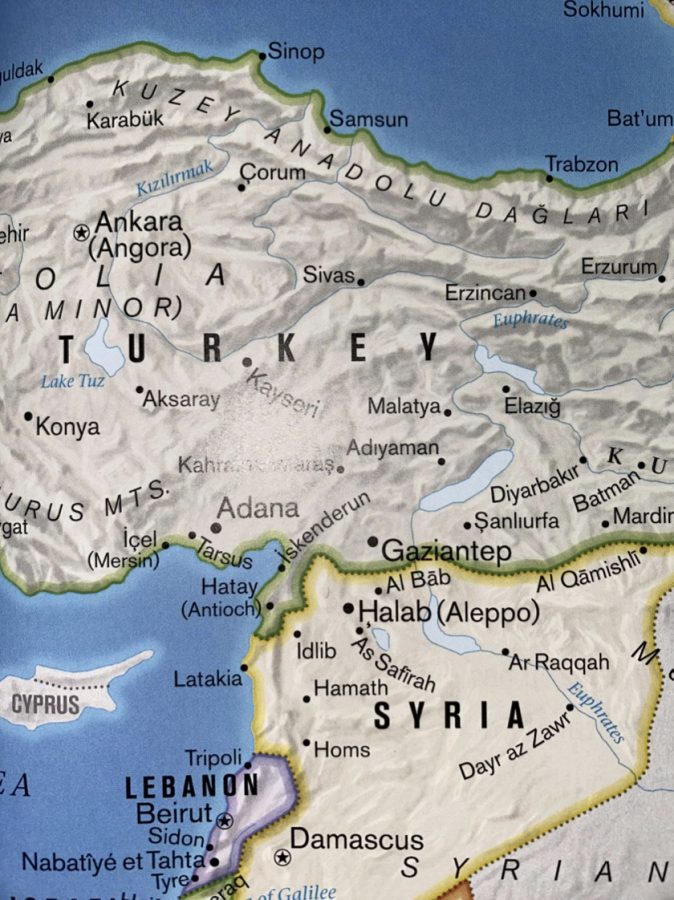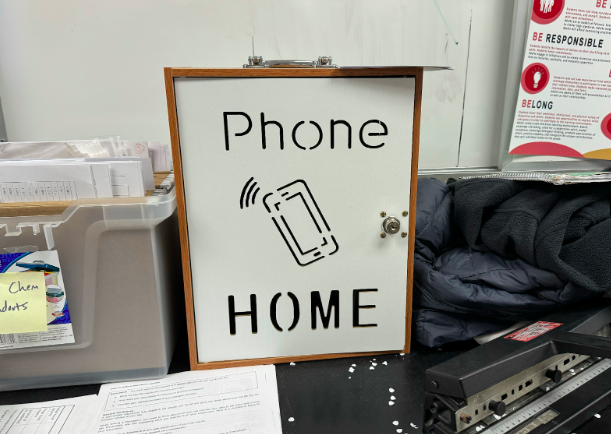Kahramanmaras Earthquake Leaves Turkey and Syria in Ruins
Map of Eastern Mediterranean from World Atlas: Fourth Edition by National Geographic Kids. The Kahramanmaras earthquake hit Southern Turkey and Northwestern Syria at 4:17 a.m. and measured around 7.7 on the Richter Scale.
February 26, 2023
Destruction reigns over demolished roads and fallen buildings. Nothing is present but ruins in the cities and towns evacuated after earthquakes hit neighboring Turkey and Syria on Feb. 6. Buildings are nothing but heaps of rubble, and their metal foundations are warped and twisted beyond reconstruction.
The Kahramanmaras earthquake was composed of two earthquakes that struck the countries of Turkey and Syria on Feb. 6, 2023, at 4:17 a.m. local time. The first quake began in Southern Turkey, near the Syrian border and Northwestern Syria, with the epicenter being in the Pazarcik district of Kahramanmaras, Turkey. The second earthquake hit at 1:24 p.m, and the epicenter was the Ekinözü district of Kahramanmaras.
According to the Red Cross, there were two earthquakes that measured magnitudes of 7.7 and 7.6 respectively, both of which generated extreme amounts of damage.
The death toll in both Turkey and Syria amounted to over 40,000 people, with the official death count in Syria equaling 5,500. The total deaths in Turkey numbered up to a staggering 35,418 and rising, twice that of the last catastrophic earthquake in Turkey in 1999. Many civilians have not yet been reported as dead because they are still missing, their bodies not yet recovered.
The İzmit earthquake struck the Kocaeli Province of Turkey on Aug. 17, 1999, with a magnitude of 7.6. It cost approximately $23 billion in economic loss and is also referred to as the Gölcük earthquake. It was said to be the deadliest earthquake in Turkey until now.
Aftermath
In the aftermath of the earthquakes, people huddle in temporary structures, away from the places devastated by the disaster. Food is scarce, barely able to sustain the masses, and cries of help echo out from underneath the destruction, pleading for someone to hear.
The twelve-year civil war in Syria made matters more complicated in the direct aftermath of the quake. Turkey’s involvement in the civil war began when Turkey condemned the Syrian government after an “outbreak of civil unrest,” and the conflict gradually worsened to border clashes and military interventions.
Despite the tension between them, the two countries have begun to attempt to aid their suffering provinces and repair the damage that the earthquakes caused, as well as responding to the aftershocks that continue to plague the countries after the initial two earthquakes.
According to the New York Times, approximately one million people were rendered homeless by the earthquake, and contractors have been charged with violating building codes that may be attributed to the mass of damage and destruction in the weeks following the earthquakes. Officials counted about 41,791 buildings that were damaged or had collapsed entirely during the earthquake, with about $70.75 billion in housing losses.
In the aftereffects of the quake, Turkish President Recep Tayyip Erdoğan declared a three-month state of emergency, as citizens both in Turkey and Syria continue to struggle with poverty and the damage caused by the massive earthquake. There have also been severe disruptions to sanitation and safe water access.
The Secretary General for the International Federation of Red Cross and Red Crescent, Jagan Chapagain, stated, “The most urgent needs are shelter, healthcare and sanitation, food and water.”
Sending Aid
After the devastating earthquake, Turkey and Syria need to recover and rebuild after the damage caused to their facilities and buildings. To begin working towards this goal, global aid is required.
Help has been difficult to send due to the destruction in the region, especially in areas that were greatly impacted by the earthquake damage. Sending aid to Syria has proved to be especially difficult where only five percent of the affected areas were searched.
With a lesser amount of areas searched, rescue efforts may not uncover survivors that could still be saved after being trapped in the rubble. If these rescues cease, the death count could rise as missing people will be presumed dead and more loss will accumulate as a result of this earthquake.
Rescue efforts are difficult to commence, and Turkey has ended these efforts in all but two of their provinces, Kahramanmaras and Hatay, as the search for survivors in other provinces are completed and the hopes of recovering more survivors from the destruction dwindles. In the time after the quake, rescue workers have pulled at least three people who were trapped for more than eleven days. The typical window for saving survivors is about 72 hours.
The ability to rescue people became less certain and people feared that it was too late to rescue many people who weren’t recovered in the aftermath. The Turkish government has received criticism in their ability to handle this disaster and tragedy, and there is widespread panic amongst the citizens about what the next steps will be.
Temporary structures have also been crucial to the aid effort in the two countries, as they allow citizens that were evacuated from particularly bad conditions to seek refuge from the dangerous situation and begin rebuilding what they have lost. Other countries such as China, the United Kingdom, and India have also been working to send emergency supplies and rescue teams to recover and help survivors as they recuperate from the effects of the earthquake.
Organization Efforts
Many organizations pitched in to help Turkish and Syrian citizens after the quakes affected their countries and their lives, including the Red Cross and the Red Crescent, amongst others.
In particular, the United Nations created a $397 million humanitarian appeal for Syria over a duration of three months. The World Health Organization also pledged to double the $43 million appeal in their earthquake response.
Nearby countries also offered assistance in the aftermath of the quake, helping to recover survivors and restore the region. The United Arab Emirates will send $50 million to Syria for earthquake relief efforts.
Red Cross and Red Crescent
The international Red Cross and Red Crescent network delivered aid and sent representatives to the site of the earthquake to help amid the panic. They provided temporary shelters and hot meals to sustain citizens until they could comprehend their next actions and begin the process of rebuilding their lives.
The humanitarian movement Red Crescent, part of the International Red Cross and Red Crescent network, has distributed more than thirty one million hot meals to affected people, in addition to delivering aid, healthcare and relief items on the ground. They also offer mental health and psychosocial support to earthquake survivors.
The Red Cross in Turkey has also sent more than 4,000 staff members and volunteers with food and aid to people affected by the earthquake to assist victims as part of the relief effort.
Helping Survivors
The Red Cross and Red Crescent have been particularly crucial in helping survivors of the earthquake, in addition to helping the countries rebuild, sending people out to aid victims.
Although these organizations have established and rigorous processes to address this cause, one does not have to be a part of them to contribute to the earthquake relief efforts.
Many other organizations are also donating money to help Turkey and Syria rebuild after the damage. The United States Secretary of State, Antony Bliken, visited Turkey to offer $100 million in humanitarian aid. Along with the United Nations’ $397 million appeal for Syrian aid, it has also launched an appeal for over $1 billion to fund Turkish relief operations.
Local aid organizations and organizations on the ground, like the Red Cross, may also have future volunteer opportunities for those who wish to contribute to earthquake relief. Although donations like clothes are not being accepted due to an inability to deliver them to the affected locations, donation forms and checks for the Turkey-Syria earthquake are being accepted by the Red Cross.
Some organizations that accept donations for the Kahramanmaras earthquake include savethechildren.org, redcross.org and directrelief.org. Consider donating to help these survivors to reconstruct their lives and work towards a better future.














